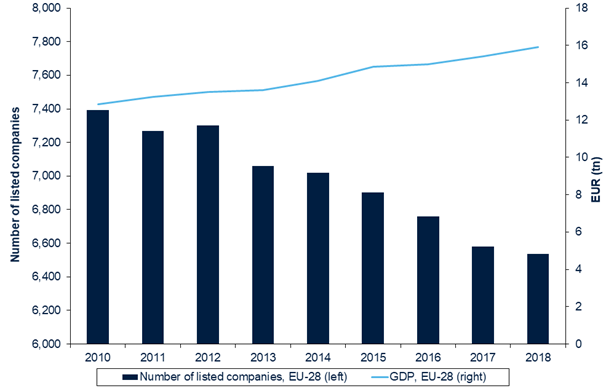Public listings

date: 02/02/2022
One of the main objectives of the Capital Markets Union (CMU) project is to make financing available to companies of all sizes at all stages of their development covering all their needs. This can be through venture capital, for example, private equity or public listing. Public listings of companies, however, remain low in the EU. The high administrative burden, high costs of listing and of compliance with listing rules dissuade many companies from accessing public markets. This is particularly true of smaller companies (SMEs). It is for this reason that the Commission, with its CMU action plan, said that it would simplify listing rules. But why does the Commission put such a great emphasis on the development of EU public markets? And what is it doing to deliver on its commitment?
Access to public markets
Analysis conducted by economics consultancy Oxera Consulting LPP shows that the number of listings in the EU-28 declined by 12%, from 7,392 in 2010 to 6,538 in 2018, while GDP grew by 24% over the same period.

Note: Number of listed companies in the EU-28 and GDP for the period 2010 to 2018
Source: Oxera analysis of stock exchange data; Eurostat.
While listing numbers vary considerably from one year to another and across Member States, overall they remain relatively subdued in the EU. By way of comparison, in the US there were roughly three times more Initial Public Offerings (IPOs) in 2020 than in the EU. The number of companies choosing to exit public markets has also been growing for a while in Europe.
While their appeal is currently fairly low, public markets have actually ensured a stable source of financing, even throughout the COVID crisis. This meant that listed companies have been able to raise funding more easily than their unlisted peers, namely through secondary issuances. More integrated and developed public markets are also important for the overall EU economy. Evidence shows that publicly listed companies tend to grow faster, generate on average more revenue and hire more staff. In this way, they contribute to economic growth and employment – as well as, in today’s context, to the economic recovery. Finally, larger and more efficient EU public markets would allow a better allocation of capital to sustainable and innovative companies and widen the investment opportunities for both retail and institutional investors.
The Listing Act
In order to prepare its forthcoming initiative in this area, the Commission has already taken a number of steps. Firstly, it commissioned studies on the topic of how to improve the access to capital markets by companies in the EU and on the functioning of primary and secondary markets in the EU. Furthermore, in October 2020, the Commission set up a Technical Expert Stakeholder Group on SMEs (TESG). In May 2021, the TESG published their final report on the empowerment of EU capital markets for SMEs with 12 concrete recommendations to the Commission and Member States to help improve SMEs’ access to public markets. The recommendations build on the work already carried out by the CMU High Level Forum and on the European Securities and Markets Authority’s MiFID II review report on the functioning of the regime for SME growth markets.
Acknowledging the seriousness of the problem and the need for the EU to act, Commission President Ursula von der Leyen announced a legislative proposal to facilitate access to capital for SMEs in her State of the Union address in September 2021. This proposal is now part of the priority actions included in the Commission work programme for 2022 and its adoption is planned for the second half of the year. The main objective of the “Listing Act” initiative is to recalibrate the listing regime so it becomes less burdensome for companies, in particular SMEs, to list in the EU. The proposal will assess the rules applicable to companies going through a listing process and companies already listed on EU public markets to cut red tape while preserving a sufficient degree of transparency and protection for investors. For example, the Commission will look into the costs of different types of prospectuses that must be published by companies when offering securities to the public or seeking listing on a regulated market. It will also look into how to reduce the size and length of a prospectus in general. In addition, the Commission will assess how it can introduce targeted easing of some of the requirements laid down by the Market Abuse Regulation.
Seeking feedback
As part of the Listing Act initiative, the Commission has launched a consultation to gather stakeholders’ views on the need to make listing on EU public markets more attractive for issuers and on how this can be achieved.
The consultation runs until 11 February 2022 and includes two parts – a shorter one for the general public and a more targeted and technical one aimed at capital market specialists and key stakeholders. The consultation is broad and looks into all elements of the listing regime, including company law (e.g. multiple voting rights) and corporate governance, as well as an alternative way of listing via special purpose acquisition companies (SPACs).
Read more on the Listing Act
